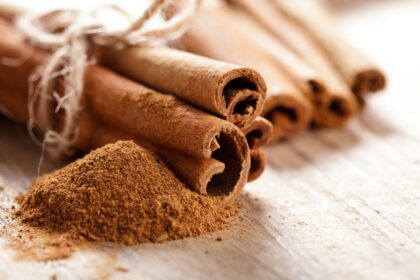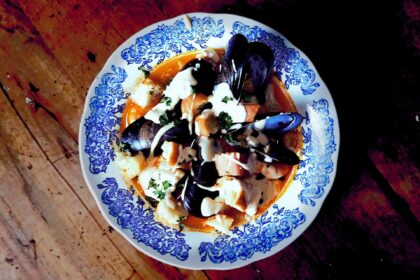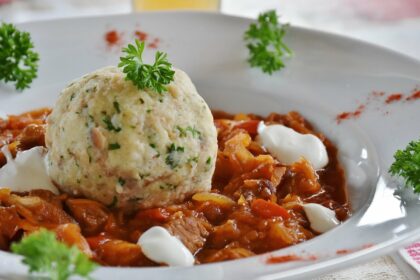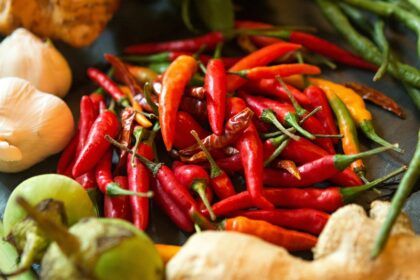When people think of street food, typically images of locals who may or may not have washed their hands churning out cheap, fly-covered meals comes to mind. In New York City in particular, many imagine simple pretzels, hot dogs resulting in intestinal issues and roasting nuts that don’t really make a meal. Now, however, there’s a new restaurant working to change the way people view and experience street food: Rasa.
Opened on December 12, 2013 in Greenwich Village, Rasa means “taste” in Malay and is the name of the village where siblings and restaurant owners Camie and Tommy Lai grew up. Rasa’s menu offerings focus on Malaysian street food and comfort dishes, with Chef Tommy Lai being New York’s first-ever Malaysian chef to receive a Michelin star, which he earned at his previous restaurant, Laut.
“Rasa is a life-long dream of ours,” says Camie. “We wanted to create an outlet to showcase our mother’s home cooking and Malaysia’s street food. We’re looking to launch culinary programs soon as well at Rasa so that we can share our mother’s culinary knowledge with foodies interested in Malaysian food.”
For guests in the mood for traditional Malaysian street food dishes, Rasa is one of only a handful of restaurants in New York City to do this in a way that incorporates the different communities in Malaysia. Some popular options include the “Malay Curried Wings” fried with turmeric and curry spices; “Mini Curry Puffs” stuffed with chicken, curry and potatoes; and “Penang Assam Laksa,” a hot and sour noodle soup. This last dish is particularly interesting, rarely found in Malaysian restaurants around the U.S. due to its difficulty in preparing. The complex dish — which is touted as putting Malaysia on the map as a culinary destination — features a homemade fish broth stewed with lemongrass, chilies, and tamarind. Rice vermicelli is added, along with sliced onions, cucumber, red chili, mint leaves, pineapple, and ginger flower, igniting almost every taste bud with hints of seafood, sweet, salt, earth, heat, spice, and tang.
To understand Malaysian cuisine you’ll need to comprehend its fusion of cultures. The three main communities in Malaysia include the Malay, Chinese and Indian, as a diaspora occurred over centuries with Chinese and Indian’s immigrating from their homelands. Cultures began blending — especially through the food — and Rasa’s menu allows you to explore this through your palate. For example, while Indian food doesn’t typically contain noodles they borrowed them from the Chinese — as well as spices from the Malays — to create their own version of Mee Goreng. While the traditional Malaysian version is made with instant Maggi Noodles, fried onions, fried egg and chili, the Indian variety features egg noodles topped with bean sprouts, shrimp fritters, tofu, eggs, tomatoes, lime, potato, fried shallots and homemade shrimp paste and chili sauce (and often ketchup to taste, if requested). Although certain ingredients are similar they’re very different, the Indian version being slightly sweeter with a more eggy texture.
One can also look at the curries featured on the menu, for example, the Yong Tau Foo Curry Mee. While the Chinese don’t typically make curry, in Malaysia these people borrowed the cooking styles and ingredients of the Malays and Indians to create a lighter curry with a thinner broth containing thin rice noodles topped with beansprouts, okra, eggplant, stuffed chili, and tofu skin and puffs.
Rasa also features a few dishes you truly won’t find anywhere else, namely because they’re made from family recipes. For example, one of their tastiest and most difficult to make dishes comes in the form of a starter: a Malaysian cupcake featuring dried shrimp paste, pickled radish, fried shallot and scallion. While the sticky rice has an almost sweet essence, the shrimp paste gives it a shellfish flavor.
“Tommy earned a Michelin star with his previous restaurant, becoming the first Malaysian chef in New York to do so,” explains Camie. “The recipes are courtesy of our mother and we’re also trying to feature less common Malaysian dishes and sticking as true as as possible to the authenticity of these dishes. In the coming weeks and months, we hope to showcase less well known Malaysian street food dishes as well including “maggi mee goreng” and Rasa’s version of the much beloved Ramly Burger.”
Make sure to also order a teh tarik, a Malaysian pulled tea found in many street stalls. During preparation black tea is poured back and forth between two cups for a frothy texture and condensed milk is added to sweeten the beverage, which has a slightly chocolate taste.
Walking into Rasa, you immediately leave NYC and are transported to the hawker centers of Malaysia, albeit in a more ambient way. Now, New Yorkers can enjoy traditional Malaysian street food in the comfort of a clean, comfortable restaurant in NYC’s Greenwich Village. It’s a truly innovative offering for NYC, and one that will hopefully expand the palates of locals and visitors.
This article originally appeared on Drive the District
Jessica Festa
Latest posts by Jessica Festa (see all)
- A Culturally-Immersive Adventure In Mongolia’s Altai Mountains - Jul 8, 2023
- This Recipe Sharing Platform Supports Women In The Culinary Industry (Labneh Recipe Included!) - Nov 5, 2020
- Hiking The Mohare Danda Community Eco-Trek In Nepal - Jun 3, 2020
- 6 Important Questions For Choosing A Responsible Yoga Retreat - May 18, 2020
- How To Create & Grow A Profitable Blogging Business (Ethically) - Jan 18, 2020






